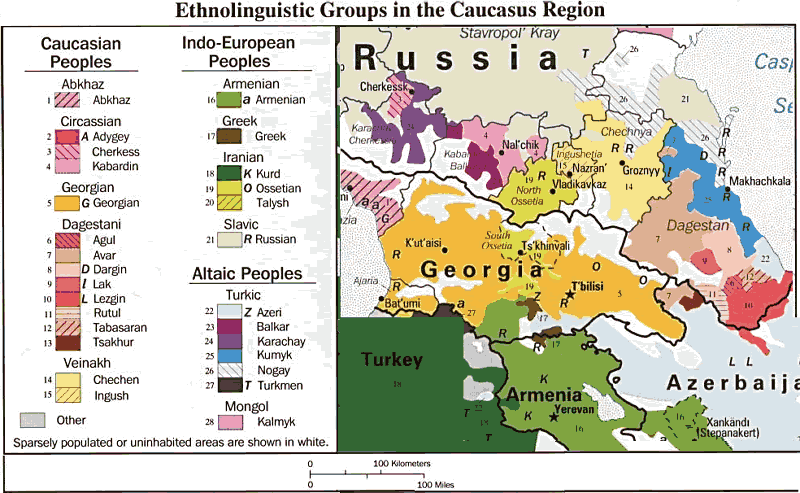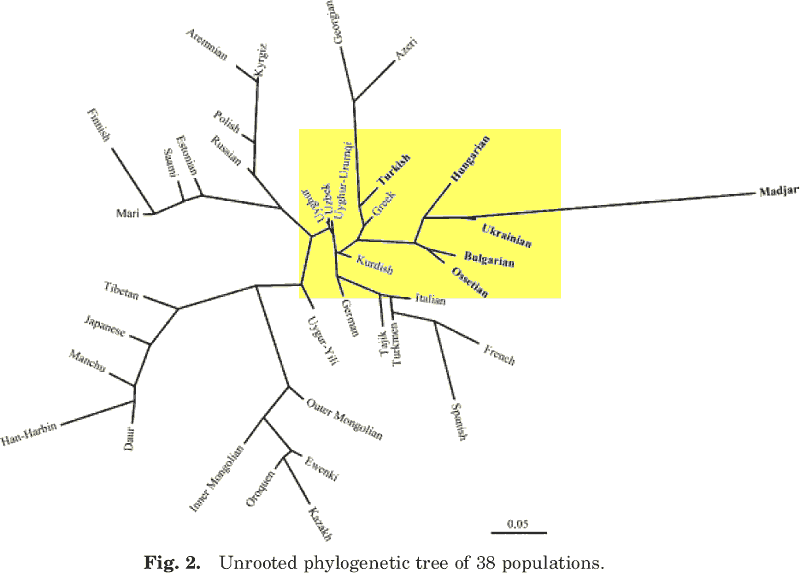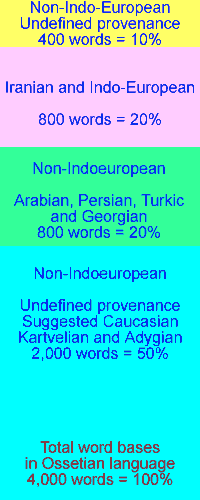Ossetian genetics
A partial peek into its nuts and bolts
Introduction

Why Ossetics??
Because the Scythian-Iranian theory follows the logic: Ossetians speak the Northern branch of the Iranian language, Ossetians are Alans, Alans are Sarmatian tribe, Sarmatians are akin to Scythians, hence Scythians were Ossetian speaking, hence linguistically the Scythians belonged to the Iranian branch of the Indo-European family of languages. A brilliant logic that, in the not less brilliant words of V.I. Abaev, "ends the light-weighted and irresponsible speculations on Scythian material which do not have anything common with a science" ( V.I. Abaev, Ossetian language and folklore, 1949, page 148). The theory, created and fanned by a coincidence of German racism and Russian national-imperialism, took hold and hardened in the Indo-European science to a status of axiom, any facts notwithstanding. The paucity of the factual material and overtrusting a handful of founding experts severely obscured the value of the fundamental facts, allowing the most improbable conclusions. The cited article, while still not devoid of misconceptions, allows a peek into the ethnic composition of the provisional descendents of the conquerors of Persia, of the glorious Macedonian opponents from Thrace to Central Asia, of the magnificent Pazyryk kurgan burials in the Altai Mountains, of the warriors that served in every army of every important empire during a span of a millennia, of the creators of the Animal Art style dispersed from Enisei to Danube, and of the creators of many kingdoms and confederations. Not a bad record for a miniscule principality that remained utterly obscure canyon populace till the Russian colonization of the Caucasus and the rise of the German racial expertise brought it forward as a banner of the Indo-European greatness in the Euro-Asian steppes.
It is outstanding that every link in the Iranian-Scythian theory is either a fraud or a blunder. The Ossetians are not Alans, and it is not Ossetians who could have spread blood group type B to the border between Scotland and England, or to the Northern Africa, or to Normandy. If you do not have it in your veins, you can't bring it over, too bad. The Ossetians are not Persian, or any other Indo-European language speakers, with their typical Caucasian glottal non-flexitive agglutinative language with a smattering of 20% of potentially Persian-derived lexicon, at least not until the Indo-European language group would convert from flexitivity to agglutination. And neither Ironians nor Digorians are Ases or ever had the endoethnonym Ases, unlike their Balkarian neighbors. The Ossetians never drunk kumis or sudja, buried their horses and their coaches and themselves in kurgans, or installed babas over them, mastered the "Parthian shot" or used a 100,000 army to encircle an area in the steppe for a hunt, or used the hunting techniques to eradicate an enemy's army, or were known in China as Yancai, "Vast Steppe", one of four Hunnish tribes. And never were taken from the Ossets the fabled treasuries that even remotely resembled the treasuries of Roman, Byzantian and Persian goods like those documented as taken from the Avars, Bulgars, Kushans, Huns and Scythians when their capitals were overrun. The genetical assessment of the Ossetians in the work is not a last nail in the coffin of the ill theory, for in an unbiased science that nail would have been driven still in the 19th century. This genetical study merely joins all other converging facts that demonstrate the absurdity of the Scythian-Iranian postulation.
The chance association of (1) "Ases - Osses", where "Ases" is one of the documented appellations of the Alans, and the "Ossets" is a wartime code in the Russian army assaulting the autonomous mountain enclaves, a code possibly distorted from the Georgian appellation "Ovseti", i.e. Ovs-land, i.e. Alan/As-land that does not carry a specific Digorian/Ironian ethnonymical bearing or historical connotations, and (2) the presence of a number of words with potential Persian etymology in the lexicon of the Ironians had inflamed the mind of an Imperial scientist, who first suggested a hypothesis. The later studies did not address the composition of the constituent languages, blending the Ironian and Digorian languages together in one quasi-common language, and expeditiously pulling out any potential Persian cognates from either language to ascribe them to that quasi-common language. V.I Abaev remains a sole underpinning of that theory, pull that pin, and the whole structure crumbles on itself. A lack of scientific probity of the Indo-European hypothesis still remains unabated.
The genetics study gives a good lead that the Ironian language has a Kartvelian substrate retaining about 40% of the lexicon with Adygian and Persian layers constituting another 20% each, and the balance 20% absorbed from the Arabic, Türkic, and languages of the nearest historical neighbors. For the Digorian language, the genetics study gives a good lead consistent with the historical record, that it evolved from the Adygian substrate, transitioned through a period of bi-linguality, and settled into the Kartvelian Ironian language, while retaining some pronounced dialectal phonetical and grammatical specifics and a differing lexicon of its Adygian substrate, the Adygian lexical layer constituting probably 20%, and the balance 20% absorbed from the Arabic, Türkic, Persian, and again the languages of a somewhat different set of the nearest historical neighbors. Both languages preserved the substratum grammatical type, absorbing all the new loanwords in the initial agglutinating language. In the absence of the detailed objective studies, these numbers present only an order of expected magnitude deduced from the genetical picture.
There is good historical information about the Persian rulers dispatching and relocating groups of guards to their northern borders, but predominantly, these settlers belonged to non-Persian speaking peoples, and with their numbers too small and their concentrations only around strategic passes like a Daryal Pass, their assimilation into the surrounding populace would be way below the resolution of the linguistical or genetic studies. Another two factors may have had a more pronounced impact on the indigenous Caucasian population. One is a widespread tradition of stealing and purchasing the brides, when the brides can be bought, captured in the raids, or imported from the Persian-speaking communities (naturally, from the non-Persian-speaking communities as well) inside Persia. The effect of the "keep up with the Joneses" syndrome over the centuries can be profound, trickling in as a small, but continuous stream into every household of the ethnically isolated communities.
The other factor are the Farsi-speaking Mountain or Highland Jews, who in the milieu of the 1940es German attack were hurriedly renamed into Tats to save them from the German extermination. These Mountain Jews lived for 15 hundred years dispersed between numerous tribes of the Caucasus, isolated in their enclaves, but integrated into the cultural and productive life of the host population. Traditionally multilingual, they mastered Adygian dialects, Türkic dialects, Kartvelian dialects, Lezginian dialects etc., in addition to Hebrew as a religious language and their own ancient (ca. 6th c. AD) Farsi vernacular, which still remains a lingua Franca between their scattered communities. Nowadays there are 100,000 Jewish Tats, plus Christian and Moslem Tats who all originated from the same Caucasus population; 525,000 Ossetians; 300,000 Adygians, etc. Numerically-wise, their numbers were quite compatible with the surrounding population, and thus they were in a position to contribute their Semitic genes and their Indo-Persian language to many of their neighbors. Traditionally, the Mountain Jews were engaged in the service occupations of leather-traders, merchants, tanners, teachers, doctors etc., widely circulating and intermingling with all their neighbors. The contribution of the Mountain Jews was thoroughly ignored by the investigators of the Indo-Persian strata in the Ossetian languages.
Surely there were other factors, not a minor of which was a traditional rape of all women after a successful raid or conquest, much like those conducted recently by Serbians in Bosnia and Russians in Chechnya (i.e. Ichkeria). But the bell shape of the distribution shows that intermittent factors dissipate with time, leaving a prehistoric population expansion as a dominating component.
Note: In the citation below I have added in parenthesis the ethnonyms behind the political euphemisms for the North Ossetian and South Ossetian designations. I also returned to the historical term of Persian for the state language of the Persia, which was renamed to "Iran" in 1934 during the heat of the Nazi wave in the 20th century. Since Iran is a multi-ethnic political entity, the Iranian language is a gross misnomer, as it may refer to Arabic, Azeri, Armenian, Kurdish etc languages, while the Persian has a 2 millennia pedigree and can't be confused. Non-authors' clarifications and comments are in shaded boxes or in blue text.
Links
http://www.eva.mpg.de/genetics/pdf/Nasidze.AnHG.2004.pdf
To cite this article
Nasidze, Ivan, Quinque, Dominique, Dupanloup, Isabelle, Rychkov, Sergey, Naumova, Oksana, Zhukova, Olga & Stoneking, Mark (2004)
Genetic Evidence Concerning the Origins of South and North Ossetians.
Annals of Human Genetics 68 (6), 588-599.
doi: 10.1046/ j.1529-8817.2004.00131.x
Citations and comments
Questions:
1 Are North Ossetians (i.e. Digorians) genetically more closely related to South Ossetians (i.e. Ironians) or to other North Caucasus groups;
2 Are South Ossetians (i.e. Ironians) genetically more closely related to North Ossetians (i.e. Digorians) or to other South Caucasus groups;
3 Which of the two prevailing theories concerning Ossetian origins (an Iranian origin, or a Caucasian origin followed by language replacement) receives support from the genetic data.
| Digorian and Ironian North Ossetian is Digorian, a people distinguished from South Ossetian which is Ironian. These two endoethnonyms reflect the composite structure of the Ossetians, whose ethnonym "Ossetian" is a Russian-made exoethnonym composed during Russian expansion into the Caucasus in the 18th-19th centuries, when some other Caucasian peoples also received various Russian monikers, like Vainakhs became "Chechens". Within the last 250-300 years, most of Digorians switched to the local dominant Ironian language. |
| mtDNA A fertilized egg contains an exact copy of the mother's mtDNA and a mixture of the father and mother's nuclear DNA, but none of the father's mtDNA. The result is that mtDNA is passed on only along the maternal line. This means that all of the mtDNA in the cells of a person's body are copies of their mother's mtDNA, and all of the mother's mtDNA is a copy of her mother's, and so on. No matter how far back you go, mtDNA is always inherited only from the mother. |
Table 2 (Excerpts) MtDNA HV1 sequence variability among the Caucasus and West Asian populations
| Population | Affiliation | No. of Haplotypes | Nucleotide Diversity | Haplotype Diversity | MPD | Tajima’s D |
| S. Ossetians, Ironians | Study | 65 | 0.018 | 0.969 | 6.44 | −1.40 |
| N. Ossetians, Digora | Study | 21 | 0.016 | 0.977 | 5.46 | −1.26 |
| N. Ossetians, Ardon | Study | 19 | 0.013 | 0.948 | 4.65 | −1.66 |
| Georgians | Kartvel | 40 | 0.014 | 0.971 | 5.16 | −1.99 |
| Lezginians | Kartvel | 34 | 0.016 | 0.985 | 5.67 | −1.52 |
| Balkarians | Türkic | 13 | 0.018 | 0.975 | 5.87 | −1.15 |
| Karachaians | Türkic | 10 | 0.015 | 0.949 | 5.31 | −1.23 |
| Iranians, Isfahan | Persian mix | 42 | 0.017 | 0.996 | 6.17 | −2.13 |
| Iranians, Tehran | Persian mix | 63 | 0.015 | 0.984 | 5.53 | −2.05 |
| Turks, Ankara | Türkic mix | 38 | 0.015 | 0.999 | 5.51 | −1.91 |
| Abkhazians | Adyg | 19 | 0.016 | 0.969 | 5.86 | −1.25 |
| Adyghe | Adyg | 32 | 0.014 | 0.954 | 4.98 | −1.55 |
| Ingushians | Adyg | 26 | 0.013 | 0.970 | 4.75 | −1.57 |
| Chechenians | Adyg | 18 | 0.012 | 0.972 | 4.40 | −1.67 |
| Cherkessians | Adyg | 37 | 0.015 | 0.986 | 5.35 | −1.98 |
Figure 2 MDS plots based on pairwise Fst values, showing relationships among
the North and South Ossetians, Caucasian, European, Central and West Asian
populations.
Ossetians are represented by stars; other Caucasus groups are
represented by circles; squares correspond to populations from Europe; Central
Asian groups are represented by diamonds; and West Asian populations by
triangles.
(Red - Ossetian, Orange - Kartvel, Green - Adyg, Dark Green - Semitic, Blue
-Türkic,
Yellow - Persian, Kurd, IE's, Magenta - UgroFinn, Black - unassigned
http://www.eva.mpg.de/genetics/pdf/Nasidze.AnHG.2004.pdf)
A
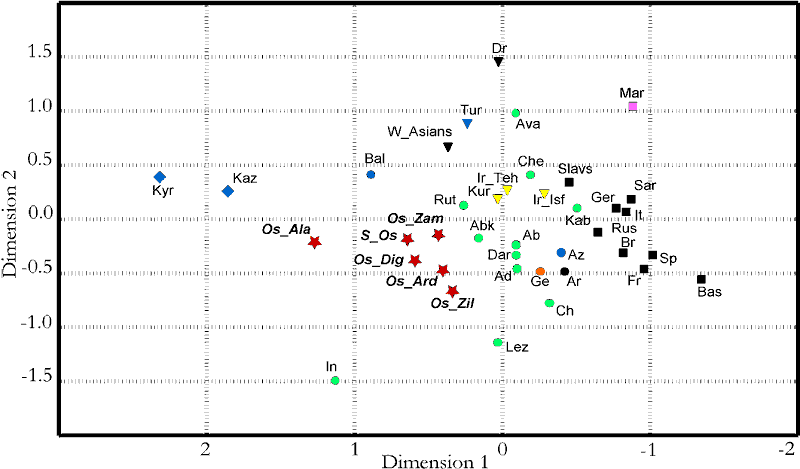
B
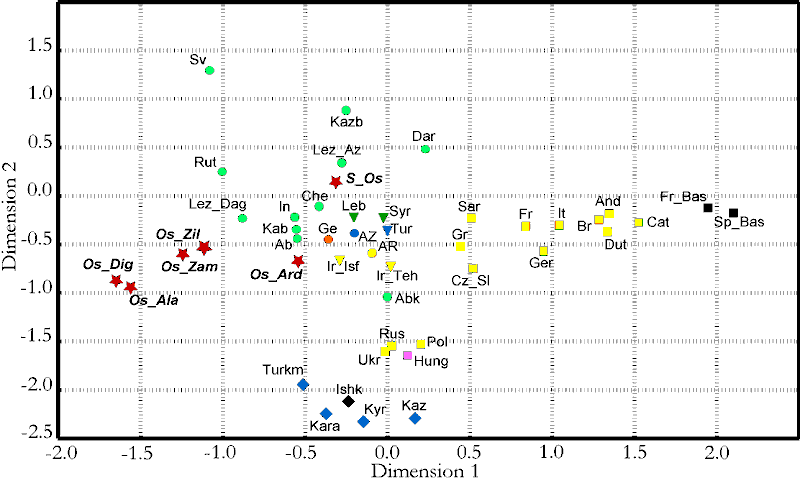
For both the mtDNA and the Y-SNP data, the geographic classification of populations gave a slightly better fit to the genetic data (in terms of higher among-group variance and lower among-populations-within-groups variance) than did linguistic classifications (Table 4, not cited here).
The mismatch distributions for the Caucasus groups are all roughly bell-shaped, suggesting prehistoric population expansions. This demographic scenario is reinforced by Tajima’s D statistic (Tajima, 1989), which is negative in all of the Caucasus groups, and significantly so in all but the Abkhazians, Balkarians, Karachaians, and Ossetians from Digora (Table 2); negative values of D, together with bell-shaped mismatch distributions, are signatures of population expansions.
The correlation between the geographic and genetic (pairwise Fst) distances separating pairs of Caucasus populations is statistically insignificant. Removing the Karachaians and other possible outliers (Ingushians, Lezginians, Abkhasians, Balkarians, North Ossetians (Digora) and South Ossetians) resulted in a correlation that was slightly higher but still non-significant.
| Ossetians from Digora The table 2, as well as comments of the results, emphasize the genetic distinction of the Digorians from the Ironians, and their similarity with the Adyg group. It is further accentuated by the necessity to exclude the Digorians, and Karachaians and Balkarians, as well as other pairwise Fst outliers including Ironians, as geographic/genetic recusants. |
The mtDNA data suggest a common female origin for North and South Ossetians. With respect to mtDNA, Ossetians are significantly more similar to Persian groups than to Caucasian groups. A common origin of Ossetian women from Persia, followed by subsequent male-mediated imprint of their Caucasian neighbors, is the most likely explanation for these results.
Ossetians are more distant female origin from Armenians, the other Indo-European-speaking population of the Caucasus with average Fst= 0.030, than from Caucasian-speaking populations (average Fst= 0.026). However, Ossetians are significantly closer to Iranian-speaking populations from Isfahan and Tehran (average Fst= 0.019) than to Caucasian-speaking populations (average Fst= 0.027). The same trend holds when we compare haplotype sharing between Ossetian and Iranian populations versus Ossetians and their closest geographic neighbors from the Caucasus. South Ossetians (i.e. Ironians) share just 4% of their mtDNA sequences with Georgians, whereas they share 12% and 19% of their mtDNA sequences with Iranian-speaking groups from Isfahan and Tehran respectively. The haplotype sharing between North Ossetians (i.e. Digorians) and Iranian groups varies from 13% to 31%. With Ingushians, their closest eastern geographic neighbors, North Ossetians (i.e. Digorians) share from 22% to 33% of their mtDNA sequences. With Kabardinians, their closest western geographic neighbors, North Ossetians (i.e. Digorians) share 26% to 54% of their mtDNA sequences.
| So, Digorians share with Ingushians 22% to 33% of their
mtDNA, with Kabardinians 26% to 54% of their mtDNA, for a total of 48% to
87%, but still they are closer to the multi-ethnic Iranian samples with whom
they share a whopping 13% to 31%. Really, seek, and you will attain. Ironians have non-Iranian mtDNA 81% to 88%, but still they are found to be closer to the multi-ethnic Iranian samples with whom they share a whopping 12% to 19%. Just keep seeking. |
| So far so good with maternal mtDNA. Now let's turn to paternal Y chromosome |
| Y chromosome Y chromosome is known as one of two the sex chromosomes, called X and Y. Of our 46, 44 are shared between the sexes; the remaining two are X and Y chromosomes. Females have two X chromosomes and men have one X and one Y chromosome. The Y chromosome contains information that determines the male sex and is inherited from father to son. The Y chromosome is passed down from generation to generation with relatively few changes in its DNA, because it escapes the recombination process that reshuffles information in the other 44 chromosomes. This means that the record of the past written in Y-chromosome DNA is relatively simple to interpret, it is a history of male lineages. In the DNA of the Y chromosome are found very rare binary markers Single Nucleotide Polymorphisms, two men sharing a particular SNP state in their DNA almost definitely inherited this from a shared ancestor, who may have lived many thousands of years ago. Single Nucleotide Polymorphisms, or haplogroups can be arranged into a 'family tree', or phylogeny. Two men with different haplogroups do not share a recent common ancestor. |
Figure 1 (Excerpts) Y-SNP haplogroup frequencies.
| S. Ossetia Ironians | N. Ossetia Digorians | N. Ossetia Ardonians | Balkars |
|---|---|---|---|
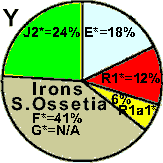 |
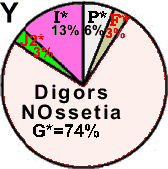 |
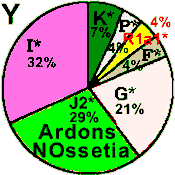 |
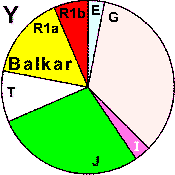 |
It is clearly visible how grossly dissimilar are the Ossetian Ironians and Digorians, they look like belonging not to the neighboring canyons, but opposing ends of the continent. Significantly, V.I.Abaev's linguistical manipulations are based not on Iron, but on Digor dialect. In the Y-DNA part, Digors are notably very close to Balkars, with evidence of different admixtures in their compositions. For comparison, here are the Persian graphs, with somewhat relative similarity between Isfahan and Ironians :
| Legend - NasidzeColors | Persians Tehran | Persians Isfahan |
|---|---|---|
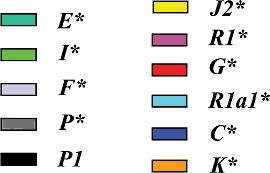 |
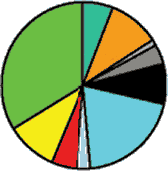 |
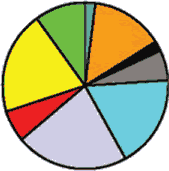 |
| Unfortunately, the study by Nasidze et al. for some reasons did not
include the Türkic Balkars and Karachays, making this Ossetian study deficient
and indicating a biased research, whatever the rationalization of the exclusions
may be. The Turkey Türks, taken for comparison in the study, are clearly not the
nearest neighbors of the Ossetians, making the Türkic comparison lacking.
These comparisons would be especially productive in light of the information
that the Digorians were Türkic-speaking before their conversion to the Ironian
language. The ethnolinguistic map below helps to illustrate better the
significance of this "omission": Digorian neighbors, clockwise - Georgians (Kartvelian), Balkars (Türkic), Kabardinians (Adygs), Chechen-Ingush (Vainakh), Georgians (Kartvelian), Ironians (study) Ironian neighbors, clockwise - Georgians (Kartvelian), Digorian (study), Georgians (Kartvelian), Armenians (Armenian) http://www.lib.utexas.edu/maps/commonwealth/ethnocaucasus.jpg
|
| Population | Language | R1b | R1a | I | E1b1b | E1b1a | J | G | N | T | L | Others | Studied |
|---|---|---|---|---|---|---|---|---|---|---|---|---|---|
| Balkarians | Altaic (Turkic) | 13.2 | 13.2 | 2.6 | 2.6 | 0.0 | 23.7 | 28.9 | 0.0 | 0.0 | 5.3 | 10.5 | 89.5 |
| Balkar Türks http://www.genos.hr/data/2008_European_Journal_of_Human_Genetics_Battaglia_Fornarino_Y-chromosomal_evidence.pdf |
Karachay Türks |

 |
 |
The Y-haplogroup data indicate that North Ossetians (i.e. Digorians) are more similar to (their neighbors) Adygs (Kosogs in Rus annals, in Türkic "Cliff Tribes"), a major constituent of the North Caucasian groups, and South Ossetians (i.e. Ironians) are more similar to (their neighbors) Georgians, the leading member of the Kartvelian group and a major constituent of the South Caucasian groups, than to each other.
Pairwise Fst values (Fixation index) indicate substantial differences between South (i.e. Ironians) and North Ossetians (i.e. Digorians) (Table 2). The average Fst value between these groups was 0.330, significantly higher than between the other North and South Caucasus groups (average Fst = 0.190); by contrast, the average Fst value between South Ossetians (i.e. Ironians) and other North Caucasian populations (i.e. Adygs) (excluding North Ossetians) was only 0.101, and the average Fst between South Ossetians (i.e. Ironians) and the other South Caucasus groups (i.e. Kartvelian) was 0.126. North Ossetian (i.e. Digorians) populations were almost as distant from South Caucasian (i.e. Kartvelian) groups as from South Ossetians (i.e. Ironians) (average Fst value, excluding South Ossetians, was equal to 0.298), while the average Fst value between North Ossetians (i.e. Digorians) and other North Caucasian populations (i.e. Adygs) was significantly lower (average Fst= 0.231). Despite the fact that North Ossetians (i.e. Digorians) showed greater similarity with other North Caucasus (i.e. Adygs) populations compared with South Ossetians (i.e. Ironians), the difference in Fst values is not significant (i.e. Digorians are ca. equidistant from Adygs and Ironians).
Pairwise Fst comparisons between Ossetians and Armenians (the Indo-European speaking group from the Caucasus) showed that Ossetians are closer to this group (average Fst= 0.144) than to the Caucasian-speaking groups (average Fst= 0.213). However, the difference in average Fst values is not statistically-significant. Also, Ossetians are about as distant from Iranian-speaking groups from Isfahan and Tehran (average Fst= 0.204), as from non-Indo-European speaking West Asian groups (average Fst= 0.215; t = 0.103, p = 0.920) (i.e.Ossetians are ca. equidistant from Iranians and Turks and Arabs).
The MDS analysis (Figure 2B) further illustrates the patterns observed in the pairwise Fst comparisons. South Ossetians are distinct from a loose cluster of the North Ossetian groups. The South Ossetians cluster with South and North Caucasian groups and with West Asian groups. Ossetians from Ardon are somewhat separated from the other North Ossetian groups, being closer to the cluster of Caucasian and West Asian groups. The overall high level of Y-chromosome diversity exhibited by Ossetian populations is reflected in the large area they occupy on the MDS plot. We also repeated the MDS analysis without South Ossetians, in order to use information for the haplogroup G*(M201). The result of this analysis (not shown) did not reveal any differences from the analysis without haplogroup G*(M201).
Figure 3 Median network constructed based on Y chromosome
STRs on the background of Y-SNP haplogroup G (M201).
Cluster A corresponds to Y-STR haplotypes found in the Digora population,
while cluster B corresponds to the Y-STR haplotypes found in the rest of
Ossetian groups.
(
http://www.eva.mpg.de/genetics/pdf/Nasidze.AnHG.2004.pdf)
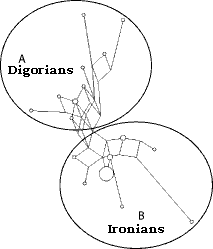 |
ADD test: Do the balls touch each other? Hint: For a complete answer click on the link above. |
The Ossetians (in this case, Ironians) speak a language with reportedly 20% Persian admixture, where the "Persian" is a documented mixture of Hindi, W. Semitic, Türkic and Dravidian languages of the period from the 6th c BC to pre-Pahlavi 3rd c AD. Does the Persian admixture exists because they are directly descended from a Persian-speaking group, or is it because Ossetians, who are genetically resembling their geographic neighbors in the Caucasus, mixed their ancestral Caucasian language with a Persian language, after contact with a Persian-speaking group?
|
Information missing from Nasidze study happened to be included in the study by A.Z. Bıro, A. Zalan, A. Volgyi, and H. Pamjav Phylogenetically, the Ossetins are way closer to Slavo-Türkic Bulgarians, Slavo-Türkic Ukrainians, Ugric--Türkic Hungarians then anything that has to do with the Indo-Europeans (Fig. modified for orientation and presentation):
|
|
V.I. Abaev's lexical stratification of the indiscriminate Ironian + Digorian Ossetian language conglomerate.
Akin to stratification of a fish soup/beef stew combination, or English/Aztecan
combination.
|
||||||||||||
Answers:
Q1 Are North (i.e. Digorians) and South Ossetians (i.e. Ironians) more genetically similar to each other, or to their geographic neighbours (i.e., Caucasian-speaking populations in the North and South Caucasus, respectively)?
A1 The results are somewhat different for mtDNA vs. the Y-chromosome. North (i.e. Digorians) and South (i.e. Ironians) Ossetians do cluster somewhat in the MDS plot based on mtDNA (Fig. 2A), which may indicate a common origin. However, for the Y-chromosome, North Ossetians (i.e. Digorians) are more similar to other North Caucasian populations, and South Ossetians (i.e. Ironians) to other South Caucasian populations, than to each other.
There is no indication in the Y-chromosome of a particularly close genetic relationship between N. Ossetians (i.e. Digorians) and S. Ossetians (i.e. Ironians). If they did have a common origin in the past, it has apparently become obscured by subsequent gene flow with their geographic neighbors on the same sides of the Caucasus Mountains (i.e. if at Neanderthals were not found any wires or poles, their phones were wireless).
Q2 Are North Ossetians (i.e. Digorians) genetically more closely related to South Ossetians (i.e. Ironians) or to other South Caucasus groups?
A2 Genetic distances between North Ossetians (i.e. Digorians) and South Ossetians (i.e. Ironians) are similar to those between North Ossetians (i.e. Digorians) and South Caucasus (i.e Kartvels) groups, but the genetic distances between North Ossetians (i.e. Digorians) and other North Caucasus (I.e Adygs) groups are much smaller.
Q3 Which of the two prevailing theories concerning Ossetian origins (an Iranian origin, or a Caucasian origin followed by language augmentation) receives support from the genetic data.
Average pairwise Fst values are smaller between Ossetians and Persians than between Ossetians and Caucasians for both mtDNA and the Y chromosome, significantly so for mtDNA, which should have substantiated a Persian origin of Ossetians. Subsequent and largely male-mediated breeding between female Ossetians and neighboring groups in the North and South Caucasus, respectively, would explain the greater similarity between Ossetians and Caucasians for the Y-chromosome (i.e. mamas have some Persian blood, but papas don't)
In conclusion, the genetic results are supported by the archaeological record, in that they reflect a presence of a common Persian origin of South (i.e. Ironians) and North (i.e. Digorians) Ossetians along the female line, as well as a genetic footprint of ancient reproduction in the North Caucasus that mostly involved male individuals. Thus, genetic studies of such complex and multiple reproduction as the Ossetians can provide additional insights into the circumstances surrounding such crossbreeding.
| Looking at the facts presented by the authors, the
conclusion number 3 seems to be not only unsubstantiated, but in a direct
opposition of the facts and analysis given in the body of the work. The conclusion number 3
is clearly a direct objective rather than sought, and it does not allow any facts to get in its way. And the results are clear: Ossetians are local people, Georgians and Adygs respectively, who had a traditional taste for Persian women, and the imported females brought into their genetics and their language a small admixture of Persia. So did other peoples, Slavs, Türks, Greeks, and many others. This admixture did not changed dramatically either the genetic composition, nor the folk traditions, nor their Caucasian language. No relation to the Scythian peoples, their history, their language and their genetics neither Georgians, nor Adygs do not have. The cornerstone of the Scytho-Iranian hypothesis is nothing other then forgery. |
